Dating back to ancient Egypt and peaking in popularity in Western Europe in the 16th and 17th centuries, the singerie (French for “monkey trick”) is a subgenre of satirical art that depicts monkeys wearing human clothes and mimicking human behaviour. The subject’s first occurrence is attributed to Flemish painter Pieter van der Borcht the Elder (1530-1608), and later seen in France in the work of Rococo artist Jean Berain (1640-1711), who featured mischievous monkeys dressed in human clothing in his arabesque designs of the late 17th century. At this point, the singerie was more of a stylized portrayal of light comedy, rather than a commentary on human behaviour; to dress an unaffected monkey in human clothes doing human deeds was merely a droll example of the lower order mindlessly imitating the higher order.
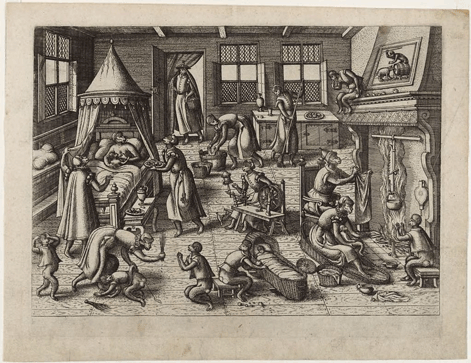
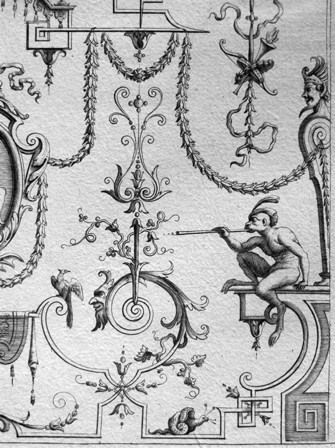
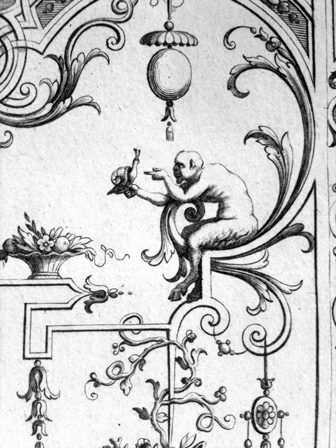
David Teniers the Younger (1610-1690) and Antoine Watteau (1684-1721) were among the first to portray the narrative in a more satirical manner, giving their monkey subjects human-like agency, and thus reflecting the similarities between a monkey mimicking a human, and a human mimicking other humans. In a post-Darwin era, German painter Gabriel von Max (1840-1915) transformed the genre to depict the monkeys not only with agency, but with a sense of contemplation of their own existence. This portrayal called into question the matter of performance, the true meaning behind the “monkey trick,” and whether or not these monkeys were merely copying humans, or if they were in fact already so similar to humans.
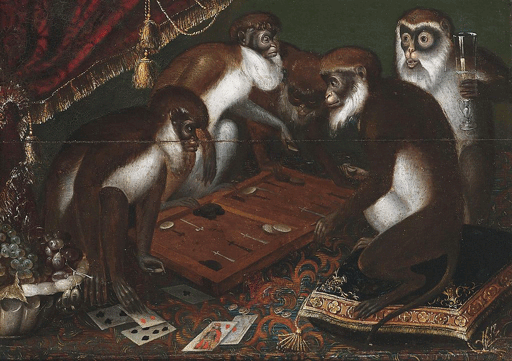
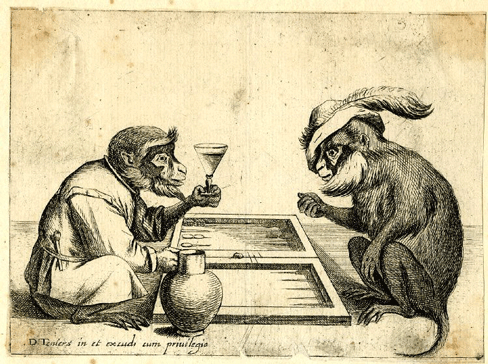
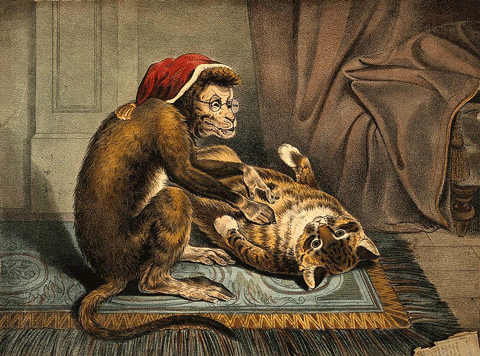
The distinction of the singerie as a genre is often credited to David Teniers the Younger, who at the very least contributed greatly to the popularity of the singerie in Western art. He built on the earlier decorative motifs featuring monkeys wearing human clothing and acting in a destructive manner. In doing so, Teniers constructed highly detailed narrative images that depicted large groups of monkeys as allegories of human folly, influencing the work of Jan Brueghel the Younger (1601-1678), who used monkeys to satirize mass consumerism in his painting Allegory of Tulip Mania (1640). As they were often considered akin to proto-humans, a poor version of a more sophisticated species, monkeys symbolised shamelessness and imbecilic behaviour. Though Teniers’ Allegory of Vanitas (1633) was not a singerie painting, the tableau features a monkey in a fool’s costume, chained to a ball and peering through the wrong end of a telescope. The fool monkey in relation to Vanitas indicates the existential absurdity or potential meaninglessness of life and of the pursuit of knowledge.
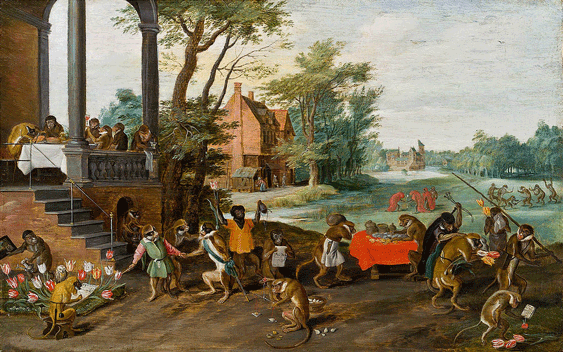
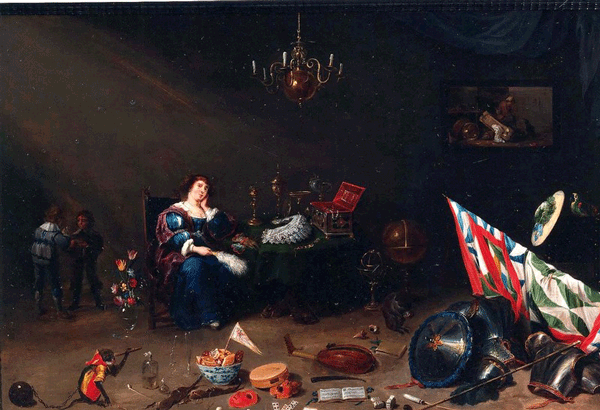
The painting Smoking and Drinking Monkeys (1660) is allegorical of the destructive nature of human vice, in a critique of the compulsive routines humans are prone to creating. In a more controversial and favorite subject of Teniers, Guardroom with Monkeys and Festival of Monkeys (1633) portray scenes of military convention. In a critique on the infrastructures and customs of war, Guardroom with Monkeys plays a typical guardroom motif in painting popular in the era: a large room with off-duty soldiers gathering in a convivial atmosphere. The monkey soldiers are awkwardly dressed, with kitchenware on their heads instead of helmets; at the doorway and focal point of the painting, two monkeys restrain a civilian cat, well-dressed in high-class attire, calling into question the validity of militaristic authority. A similar critique is made in Festival of Monkeys, in which monkeys gather outside a military tent in a town square, and a flyer with the image of an owl is posted above the tent door, reading in Flemish, “what good are candle and spectacles if the owl does not want to see and read.”
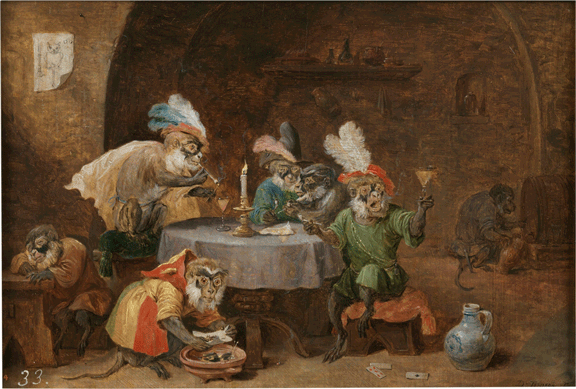
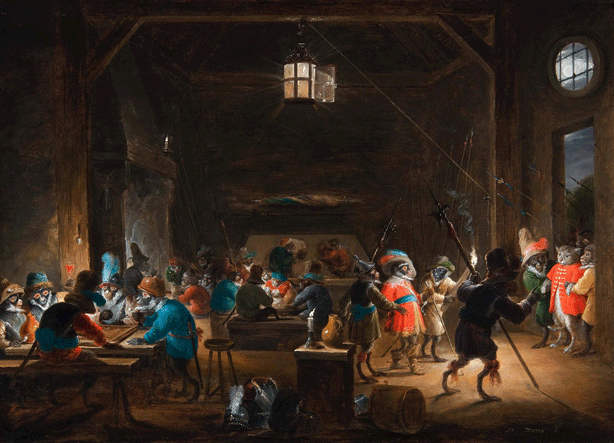
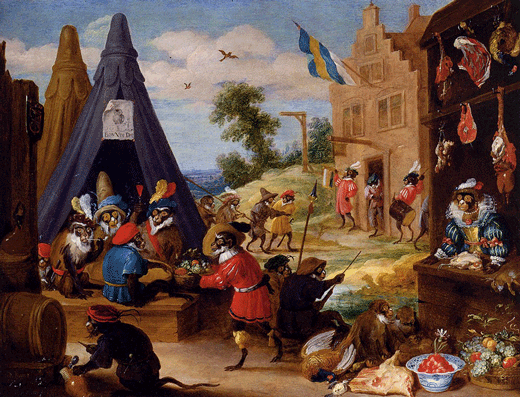
In a more lighthearted approach, Antoine Watteau’s The Monkey Sculptor (1710) portrays a monkey as a mindless imitator of an artist, the joke being that the monkey does not understand the complexity of the actions it performs. Watteau’s monkey seems pleasantly good-natured with a natural smile, adorned in human costume, and preparing to make an impression on a sculpture with a chisel and hammer. This of course will end in the destruction of the sculpture, considering the monkey is set to take a full swing at a completed sculpture. The face of the bust turns her head away from the impending strike in a humorously woeful preparation of doom at the hands of the ignorant monkey. Both the sculpture and the monkey in this painting are anthropomorphized in a satirical illustration of amateur art making. The portrayal of a thoughtless monkey in the process of misguidedly making “art” would be subverted later in the paintings of Jean Simeon Chardin (1699-1779) and Alexandre Gabriel Decamps (1803-1860). A series of monkey paintings by Gabriel von Max would also come to depict monkeys in mindful contemplation of art.
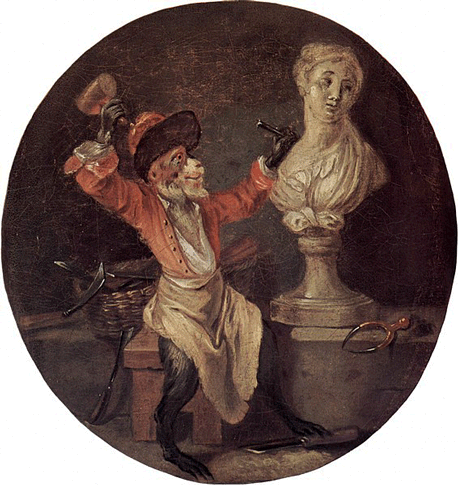
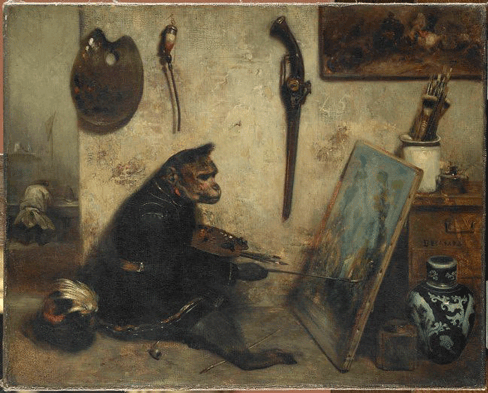
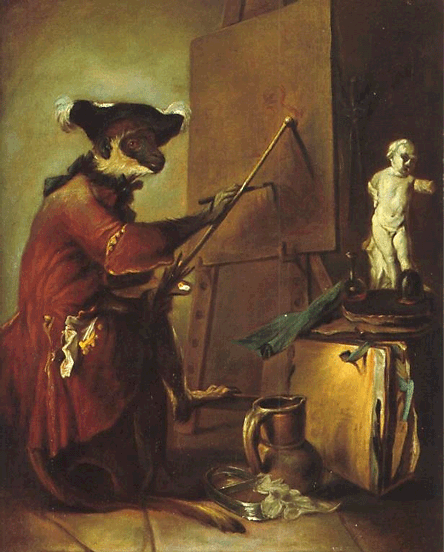
Jean Simeon Chardin and Alexandre Gabriel Decamps, whose paintings both titled The Monkey Painter, 1704 and 1833 respectively, feature their subjects as serious art makers. The monkeys in both paintings solemnly observe and consider their process, evoking a sense of soulfulness and introspection. The treatment of the monkey as a thoughtful creature is expanded upon in the work of German painter Gabriel von Max, who portrayed his monkeys with empathy, showcasing them as curious and enchanted by art. The description by Sotheby’s of Max’s painting A Visit To The Artist’s Studio (1891), compares the work to Max’s earlier painting, Monkey’s As Judges Of Art (1889), stating that the work, “may present an ironic (and perhaps vengeful) assessment of [Max’s] audience.” This assessment is predicated on the assumption that a comparison of art critics to monkeys is made in the same vein as earlier singeries, but the statement neglects to consider that a comparison was not an insult for Max, but more likely a compliment.
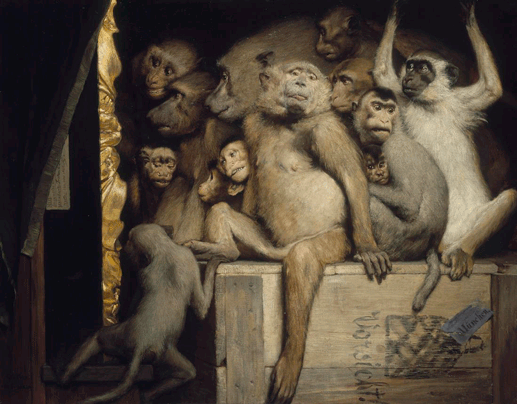
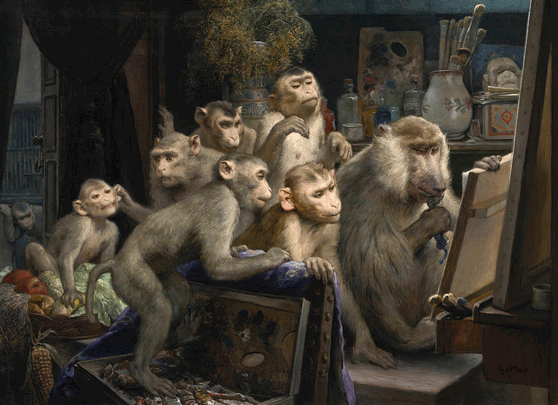
Max, a contemporary and great admirer of Charles Darwin (1809-1882) was also a self-professed evolutionist, and it was his love of evolutionary biology that turned a potential career in science to one of painting. For Max, as with Darwin, art was the spiritual expression of naturalism, evolution, and biology: science by no means negated the existence of a soul. Using science as inspiration, Max would spend his summers at his Stanberger Lake home, where he kept a personal museum of biological specimens. He spent his days surrounded by the troop of macaque monkeys he kept as pets. These monkeys were models for his singeries, depicted in a way that was free from the hostility and degradation typically directed towards monkeys as allegories of human shortcomings. The creatures were instead painted as thoughtful, playful, and conscious creatures. Max, according to art historian Marsha Morton, “found greater admiration [for our simian] ancestors, [compared to] his dim assessment of modern [people],” a sentiment evident in the lighthearted scene within A Visit to the Artist’s Studio. The painting is composed of a group of Max’s pet monkeys: on the left a matriarchal monkey pinches the cheek of an infant monkey who sits atop the pile of vegetables –he is clearly misbehaving. The monkey in the foreground absentmindedly steps on tubes of paint with one foot and clutches a paint-covered palette with the other in his zeal to view a painting over the shoulder of the monkey to the right. The largest monkey, perhaps the alpha, sits at the helm of the group and in front of a large canvas, as he clutches a drawing board with his left hand and his right foot while gazing transfixed upon the image he beholds. He is so focused on what he sees that he distractedly squeezes the tube of blue paint in his right hand. These details, while in keeping with the typical follies depicted in singeries, are not indicative of the monkeys’ foolishness or inferior state, but of the monkeys’ state of enchantment when viewing a captivating piece of art. While it is not clear what exactly has captured their attention, a clue in the form of a painting of a monkey within this painting rests on the shelf in the background. It is positioned to face in the same direction as the monkeys, seeming to take part in the viewing of the art, and may indicate the subject matter of the unseen painting as a larger monkey portrait. If this is the case, then the troop’s fascination with a monkey portrait indicates recognition, and self-awareness.
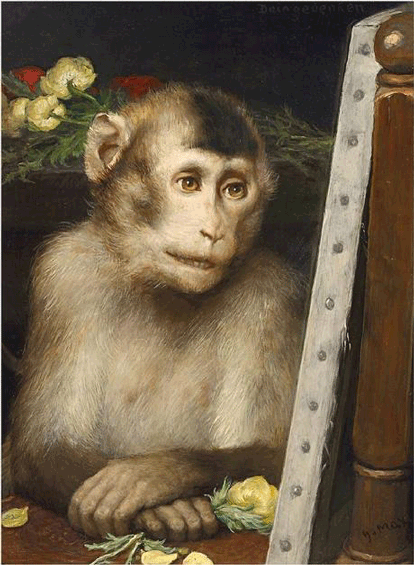
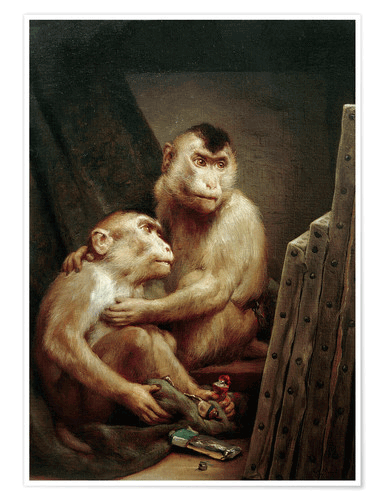
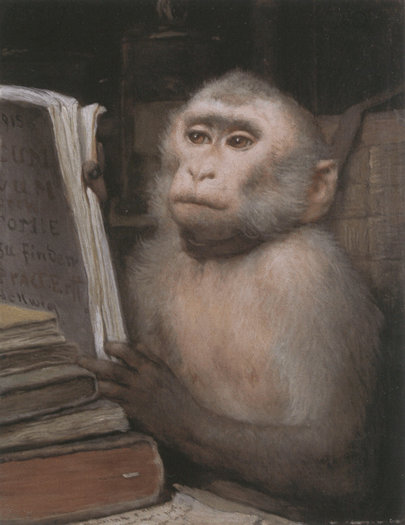
Though at first the sight of monkeys acting as humans in art may seem merely comical, the content of singeries is rooted in one of the more fundamental aspects of human complexity: to act on impulse. The compulsion to act out or mimic the behaviour of others indicates much about societal systems and psychology, the subtleties of which are captured in the depiction of the monkey, a foreign yet relatable being. The evolution, so to speak, of the singerie has progressed from monkeys as a decorative accent to monkeys as philosophers of art, but regardless of their purpose, “monkey tricks” in painting remain one of the more deceptively nuanced sub-genres in art history.
